
I recently attended the wedding of two former students that took place at the Anthony Chapel in Hot Springs, Arkansas, designed by Maurice Jennings, a former partner of Fay Jones. The influence of Jones’ celebrated Thorncrown Chapel is evident, but Jennings definitely takes the idea one step further. Situated in the Garvan Woodland Gardens, the chapel is carefully sited with a view towards Hamilton Lake. The architecture is clearly commuting with nature, and there is a beautiful, dappled light within the structure.
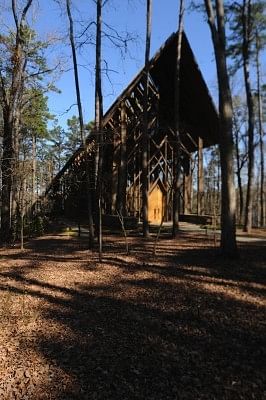

Lee and Amy had made several trips to Hot Springs before choosing to hold the wedding there, even though no one lived nearby. Hot Springs is a resort town that enjoyed its hey-day in the 1930s, with a beautiful main street, spa springs and scenic surroundings. The combination of the lovely old town and the chapel itself tipped the couple’s decision to have their wedding there. It was an amazing event and many of their friends had come in from points around the country. Eight of the twelve in the bridal party had been my students (four had been TAs), and it was great fun for me to see Lee and Amy so happy and surrounded by friends and family that care so much about them.
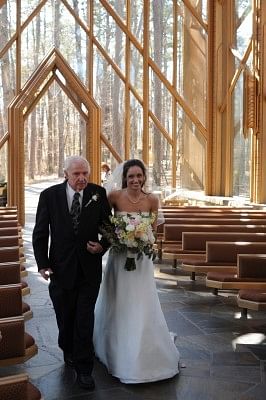
After the ceremony, it was hard not to reflect on the power of architecture, and its ability to create an occasion. What drew us all to Hot Springs was the architecture. People come from all over the world to use this chapel and, as such, it’s actually quite an economic generator for the community. It helps the town survive. But also, it creates the setting for hundreds of wonderful, memorable events every year. Again, this is what architecture does! It is not only important what a building is, but what it does and how it enriches people’s lives.
The chapel has a fascinating, complex framing utilizing a 3-D steel joint that becomes a 3-D wood truss, and this form is repeated from end to end of the 57-foot high structure. The result is a delicate, intricate ceiling, one that seems to lift itself up like branches of a tree.
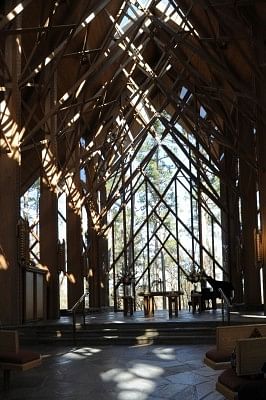
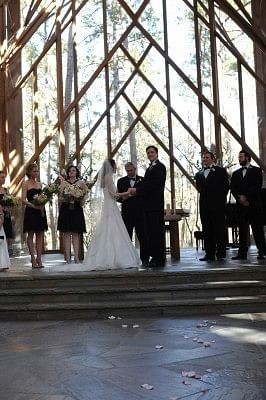
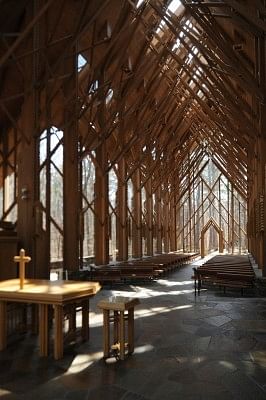
The gardens were the vision and gift of Verna Garvan; she commissioned Fay Jones to do the site plan for the gardens (including the chapel) as well as to design and build a nearby polygonal pavilion (below). Jennings, who took over Jones’ office, was then commissioned in 2004 to complete Anthony Chapel. The passion of both architects for nature, light and structure is what makes this such an elegant and uplifting place.
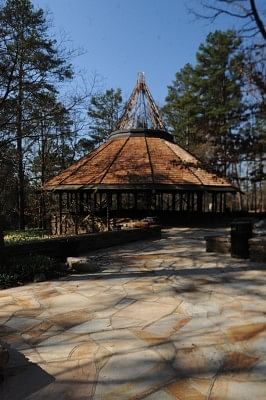

The day all came together beautifully: the setting, the stunning spring weather, the building, the friends and family, and the ceremony. What a spectacular and memorable occasion!
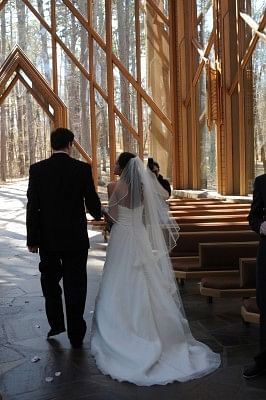
Although it may sound cliched, I live, eat and breathe architecture. I’m currently a principal in the architectural firm of PageSoutherlandPage and a professor, as well as the former dean, in the School of Architecture at the University of Texas at Austin. My teaching and my blog are aimed at educating people on the importance of great architecture in contemporary American culture.
8 Comments
These works by disciples of Fay Jones, such as this, are apt to be quite nice as long as new geometries are introduced, along with the scale and the materials which really work with their settings in this region. The work which garnered Jones so much notoriety was captivating for being simple in its scheme but somewhat more complex by way of its lattice work. There. I didn't use the word juxtapose.
I always thought there were some similarities between the Anthony Chapel and the Baughman Center at UoF. Have often wondered if they were designed by same architecture of it is just a case of design by typology?
Wayfarers Chapel, Lloyd Wright, Palos Verdes, CA
so pretty much similarities just a result of typology then?
typology of LW.:.)
Sometimes chapels and churches are amazing architectural beings. I came across this article that details the design and building of a famous church in South America: http://bit.ly/19FQnwX.
I highly recommend reading it, enjoy!
I always thought there were some similarities between the Anthony Chapel and the Baughman Center at UoF. Have often wondered if they were designed by same architecture of it is just a case of design by typology?
Baughman Center at UF made me curious, so I looked it up. The architect is John Zona (not the first, but the third). He practices in Jacksonville. He has a couple of notable works. I find his Mandi's Chapel more attractive than Baughman. I think this guy was probably schooled at UF, or in the area, and was able to absorb this style. However, the chapel at UF has many historical and local/other references, with the Gothic arch motif, an upper window that almost refers to a Gothic rose window, the layering of clerestories, and the use of curved brackets at the roof lines, so it actually seems eclectic. His work in Mandi's Chapel appears to be a simpler rendition and closer to the Fay Jones and Arkansas work vernacular.
This picture shows that he nicely layered different volumes at Baughman and it received accolades.
http://upload.wikimedia.org/wikipedia/commons/thumb/6/6e/Dsg_UF_Baugham_Meditation_Center_20050507.jpg/582px-Dsg_UF_Baugham_Meditation_Center_20050507.jpg
Don't know if the other chapel, near Tallahassee, I mentioned did.
http://www.daltonagency.com/wp-content/uploads/MandyChapelWeb.jpg
@observant thanks for the info... Mandi's Chapel does seem less layered perhaps at least from that photo..
Block this user
Are you sure you want to block this user and hide all related comments throughout the site?
Archinect
This is your first comment on Archinect. Your comment will be visible once approved.